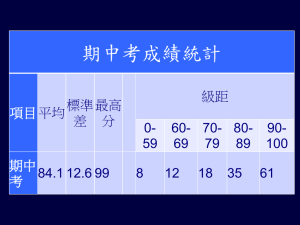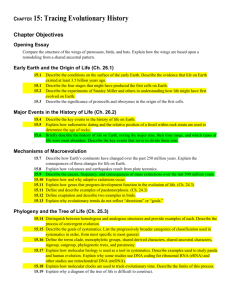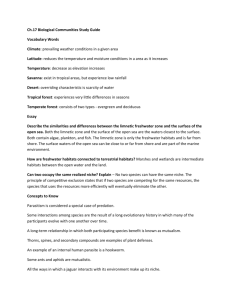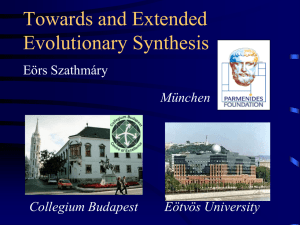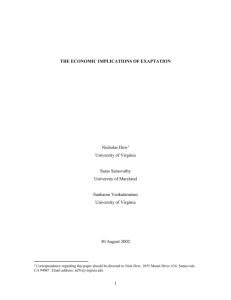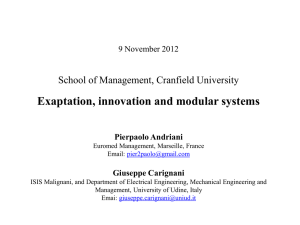Innovation in biology and technology: exaptation precedes
advertisement
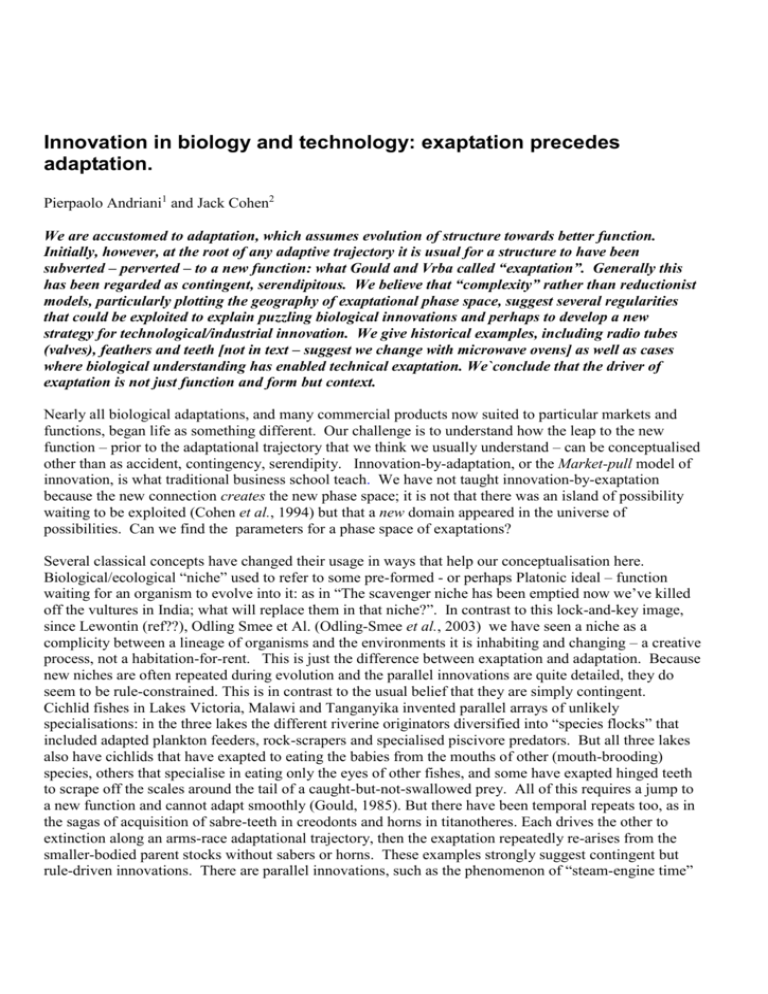
Innovation in biology and technology: exaptation precedes
adaptation.
Pierpaolo Andriani1 and Jack Cohen2
We are accustomed to adaptation, which assumes evolution of structure towards better function.
Initially, however, at the root of any adaptive trajectory it is usual for a structure to have been
subverted – perverted – to a new function: what Gould and Vrba called “exaptation”. Generally this
has been regarded as contingent, serendipitous. We believe that “complexity” rather than reductionist
models, particularly plotting the geography of exaptational phase space, suggest several regularities
that could be exploited to explain puzzling biological innovations and perhaps to develop a new
strategy for technological/industrial innovation. We give historical examples, including radio tubes
(valves), feathers and teeth [not in text – suggest we change with microwave ovens] as well as cases
where biological understanding has enabled technical exaptation. We`conclude that the driver of
exaptation is not just function and form but context.
Nearly all biological adaptations, and many commercial products now suited to particular markets and
functions, began life as something different. Our challenge is to understand how the leap to the new
function – prior to the adaptational trajectory that we think we usually understand – can be conceptualised
other than as accident, contingency, serendipity. Innovation-by-adaptation, or the Market-pull model of
innovation, is what traditional business school teach. We have not taught innovation-by-exaptation
because the new connection creates the new phase space; it is not that there was an island of possibility
waiting to be exploited (Cohen et al., 1994) but that a new domain appeared in the universe of
possibilities. Can we find the parameters for a phase space of exaptations?
Several classical concepts have changed their usage in ways that help our conceptualisation here.
Biological/ecological “niche” used to refer to some pre-formed - or perhaps Platonic ideal – function
waiting for an organism to evolve into it: as in “The scavenger niche has been emptied now we’ve killed
off the vultures in India; what will replace them in that niche?”. In contrast to this lock-and-key image,
since Lewontin (ref??), Odling Smee et Al. (Odling-Smee et al., 2003) we have seen a niche as a
complicity between a lineage of organisms and the environments it is inhabiting and changing – a creative
process, not a habitation-for-rent. This is just the difference between exaptation and adaptation. Because
new niches are often repeated during evolution and the parallel innovations are quite detailed, they do
seem to be rule-constrained. This is in contrast to the usual belief that they are simply contingent.
Cichlid fishes in Lakes Victoria, Malawi and Tanganyika invented parallel arrays of unlikely
specialisations: in the three lakes the different riverine originators diversified into “species flocks” that
included adapted plankton feeders, rock-scrapers and specialised piscivore predators. But all three lakes
also have cichlids that have exapted to eating the babies from the mouths of other (mouth-brooding)
species, others that specialise in eating only the eyes of other fishes, and some have exapted hinged teeth
to scrape off the scales around the tail of a caught-but-not-swallowed prey. All of this requires a jump to
a new function and cannot adapt smoothly (Gould, 1985). But there have been temporal repeats too, as in
the sagas of acquisition of sabre-teeth in creodonts and horns in titanotheres. Each drives the other to
extinction along an arms-race adaptational trajectory, then the exaptation repeatedly re-arises from the
smaller-bodied parent stocks without sabers or horns. These examples strongly suggest contingent but
rule-driven innovations. There are parallel innovations, such as the phenomenon of “steam-engine time”
when everyone invents steam engines, in biology “natural-selection time” for Spencer, Darwin, Wallace.
All these cases suggest that the opportunities for exaptation are at least as much to do with context as with
the nature of the tool or the nature of the task. Can we distinguish between rule-driven exaptations and the
Conway-Morris adaptational trajectories (Conway Morris, 1999). We believe his model to believe the
intelligent design promoters who maintain the same function throughout an evolutionary event.
So we have three players in the game, not just the two of form and function. There must be permissive
contexts, perhaps driving contexts, contexts that constrain toward contiguity of form and function, so that
exaptation is promoted. Riverine cichlids in a filling lake basin, and newly arrived finches to the
Galapagos are like radios and tape players that first moved into the transistor age, or early automobiles
before the emergence of motorways and gas stations. The ‘invaders’ find environmental gradients that
drive the emergence of new exapted functions. In order for the “adjacent possible” to include more
possibilities, in order for the chances of exaptational contingency to be high, diversity-generators should
be in operation. The most familiar of these are the symmetry-breaking bifurcations that result from
chains of complicity between processes: early automobiles, rare but with rich drivers, made gas stations
economically viable, and better roads, which in turn promoted diverse and economically viable
automobiles for nearly all in that culture. As the cichlids, or the finches, multiplied and diversified, new
opportunities for sympatric speciation arose (Cohen, Stewart and Elmhirst, date??). These are
‘horizontal’ exaptations, widening the phase space. Another diversity-generator is architecture
reconfiguration. Organisms, technologies and eco-systems are self-referential architectures of modular
parts and functions. If the architecture collapses, as during a biological or industrial mass extinction, then
the modules search for new architectures. Functions and tools may then be ‘vertically’ exapted in new
architectures, or bodyplans. The potential for exaptation is not to be sought in properties of a tool or its
uses but in the facilities, in that developing context, for new utilities to be engendered.
Context itself is not without rule. Ecosystem engineering (Jones et al., 1994) and niche constructionism
(Odling-Smee et al., 2003) and external physiology {Turner, 2000 #845} emphasise the feedback
between organismal traits and environmental factors. Earthworms are a classic example: they are still
‘marine’ animals that, instead of retooling their body plan to live on land, have modified their
environment to work as their external kidney (Turner, 2000). In the process they have ‘invented’ soil and
made agriculture possible. Niche construction ‘engineers’ build their own environment by ‘perverting’
environmental factors, that is by intercepting external fluxes of energy, which are then used to build
niches, thereby modifying selective pressures. Niche construction (and often the creation of new
industrial niche/sectors) starts with an exaptation, creating then a locked dance between the two pairs of
exaptation/adaptation and organism/environment.
What properties of the context are permissive for exaptations? Clearly, a sparse, almost uninhabited
region of phase space has few opportunities for the contiguities necessary to establish functional bridges
among tools, technologies or indeed species. When sound-recording began, wax cylinders, discs then
early wire recorders as electricity came into technical use, there were few contiguities. Equally, a very
crowded region probably fosters high competition, low “rents”, and unacceptable costs for the initial
stages of an exaptation, before progression on the adaptational trajectory. The early lake with few fishes
gave few if any opportunities; equally, when the ecosystem had matured into hundreds of specialised
niches, there was no physiological “room” to experiment. However, as the era of electrical-recording was
paralleled by the digital revolution in electronics, the subversion of digital compact-disc technology to
music, and then to sound-and-picture DVD’s was inevitable. Now the music-recording has leapt over
into solid memory, and adaptational trajectories involve compression techniques and display/play
development. There is a further parameter, though. Silicon Valley has exploded away from the
sparse/dense constraint. It is a multidimensional network of reconfiguration experiments. Exposure to
new contexts (projects) favours translation of tools into new functions (‘horizontal’ exaptation), whereas
cooptation of tool modules into new architectures (‘vertical’ exaptation) generates new technological
families. The system has became autocatalytic, almost ‘mesobiotic’.
In conclusion, enhanced models of evolution, based on a multilevel, hierarchical understanding of
biological and technological world, can help the innovation process. In particular, the concepts of
horizontal and vertical (or recombinant) exaptatation have the potential to provide managers (and policymakers) with an additional tool to increase the speed of innovation processes.
Cohen J, Stewart I. 1994. The Collapse of Chaos: Discovering Simplicity in a Complex World. Viking:
London
Conway Morris S. 1999. The crucible of creation: the Burgess Shale and the rise of animals. Oxford
University Press: Oxford
Gould JS. 1985. Not Necessarily a Wing. Natural History 94: 12-25
Jones CG, Lawton JH, Shachak. 1994. Organisms as ecosystem engineers. Oikos 69(3): 373-386
Odling-Smee FJ, Laland KN, Feldman MW. 2003. Niche Construction: The Neglected Process in
Evolution. Princeton University Press: Princeton, N.J.
Turner JS. 2000. The Extended Organism: The Physiology of Animal-Built Structures. Harvard University
Press: Cambridge, MA
